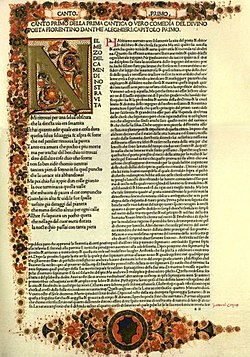ഇൻഫർണോ (ഡന്റെ)
ഇൻഫർണോ(ഉച്ചാരണം: [im'fɛrno]; ഇറ്റാലിയൻ നരകം" ) ഡാന്ത അലിഗിരിയുടെ പതിനാലാം നൂറ്റാണ്ടിലെ എപ്പിക് കവിത ഡിവൈൻ കോമഡിയുടെ ആദ്യഭാഗമാണ്. പർഗാടോറിയോ, പാരഡിസോ എന്നിവ തുടർന്നു പ്രസിദ്ധീകരിച്ചു. പുരാതന റോമൻ കവി വിർജിൽ നയിക്കപ്പെടുന്ന ദെൻടിലൂടെ കടന്നു പോകുന്ന നരക യാത്രയെക്കുറിച്ച് ഇൻഫർണോ പറയുന്നു. കവിതയിൽ, നരകം, ഭൂമിയിലെ ഒൻപതു കേന്ദ്രീകൃത സർക്കിളുകളായി ചിത്രീകരിക്കപ്പെടുന്നു. ആത്മീയമൂല്യങ്ങളെ തള്ളിക്കളഞ്ഞവരുടെയെന്ന നിലയിൽ, സാമാന്യആശയങ്ങളെയോ അക്രമത്തിലോ വഴങ്ങിക്കൊണ്ടോ അല്ലെങ്കിൽ അവരുടെ മനുഷ്യമനസാക്ഷിയെ അവരുടെ സഹമനുഷ്യർക്കെതിരെ വഞ്ചനയോ ദ്രോഹമോ ചെയ്യുന്നതോ വഴിതെറ്റിക്കുകയോ ആക്കിത്തീർക്കുന്നു "[1]ഒരു ഉപദേഷ്ടാവെന്ന നിലയിൽ, ദിവ്യകോമഡി, ദൈവത്തോടുള്ള ആത്മാവിന്റെ യാത്രയെ പാപത്തിന്റെ അംഗീകാരവും തിരസ്കരണവും പ്രതിനിധാനം ചെയ്യുന്നു.[2]

ആമുഖം
തിരുത്തുകകാന്റോസ് ഐ -II
തിരുത്തുകവ്യാഴാഴ്ച രാത്രി 24 ന് (അഥവാ ഏപ്രിൽ 7), എഡി 1300 ന്, നല്ല വെള്ളിയാഴ്ച പുലർച്ചെ നേരം വൈകി തുടങ്ങുന്നതിനുമുൻപ് ഈ കവിത ആരംഭിക്കുന്നു.[3][4] നാടകകൃത്ത് ഡാൻറേ, മുപ്പത്തഞ്ചു വയസ്സുള്ളതും അങ്ങനെ "നമ്മുടെ ജീവിത യാത്രയുടെ മധ്യപാതയിൽ" ( "midway in the journey of our life") (Nel mezzo del cammin di nostra vita) [5] ബൈബിൾ ജീവിതത്തിന്റെ പകുതി അതായത് എഴുപതു (സങ്കീർത്തനം 89:10,സങ്കീർത്തനം 90:10, KJV) എന്ന് സ്വയം പറഞ്ഞുകൊണ്ട് "രക്ഷയുടെ വഴിയിൽ നിന്ന്" മാറുന്നു (ദിർത്താ വഴിയിലൂടെ,[6] "രക്ഷയുടെ വഴി"). രക്ഷയുടെ കലാശയത്തിൽ നിന്ന് നേരിട്ട് ഒരു ഡാർക്ക് വുഡ് (സെൽവ ഓസ്കുറ)[7] നഷ്ടപ്പെട്ടതായി കവി അറിയുന്നു. അവൻ ഒരു ചെറിയ പർവ്വതം നേരിട്ട് കയറാൻ പുറപ്പെടുന്നു, എന്നാൽ തന്റെ വഴിയിൽ നിന്നും ഒഴിഞ്ഞുമാറാൻ കഴിയാത്ത മൂന്ന് മൃഗങ്ങളാൽ അവനെ തടയുന്നു: ഒരു ലോൺസ[8](സാധാരണയായി "പുള്ളിപ്പുലി" അല്ലെങ്കിൽ "ലീപോൺ")[9]ഒരു ലിയോൺ[10] (സിംഹം), ഒരു ലൂപ്പ [11](ചെന്നായ) എന്നിവയാണ്. യിരെമ്യാവു 5: 6-ൽ നിന്നെടുത്ത മൂന്നു മൃഗം, അനുതപിക്കാത്ത ആത്മാവിനെ നരകത്തിലെ മൂന്നു പ്രധാന ഭാഗങ്ങളിൽ ഒന്നിലേക്കു കൊണ്ടുവരുകയും പ്രതീകപ്പെടുത്തുകയും ചെയ്യുന്നു. ജോൺ സിർദി പറയുന്നതനുസരിച്ച്, ഇതെല്ലാം അനാവശ്യമാണെന്നും (the she-wolf); എന്നാൽ അക്രമവും മൃഗീയതയും (സിംഹം); വഞ്ചനയും തിന്മയും (പുള്ളിപ്പുലി); വഞ്ചന / തിന്മ (ചെന്നായ) എന്നിങ്ങനെ പ്രതീകാത്മകമായി ദോറോത്തി എൽ. സായേഴ്സ് ചിത്രീകരിക്കുന്നു.[12] ;
ഏരീസിൽ സൂര്യൻ ഉദിച്ചു നിൽക്കുന്ന ഏപ്രിൽ എട്ട്, നല്ല വെള്ളിയാഴ്ച പുലർച്ചയാണ്. മൃഗങ്ങൾ അവനെ തെറ്റിന്റെ അന്ധകാരത്തിലേക്ക് തള്ളിവിടുകയാണുണ്ടായത്. "കുറച്ചു സ്ഥലം" (ബസ്സോ ലോക്കോ[13], സൂര്യൻ മൗനം കാണിക്കുന്നു (എൽ സോസ്[14]).എന്നാൽ ഡന്റെ ഇദ്ദേഹം സബ് ലുലിയോയിൽ ജനിച്ചതായി പ്രഖ്യാപിച്ചു.(അതായത് ജൂലിയസ് സീസറിന്റെ കാലത്ത്). അഗസ്റ്റസിന്റെ കീഴിലായിരുന്നു താമസിച്ചിരുന്നതെങ്കിലും റോമൻ കവിയായ വിർജിലിൻറെയും ഈനിഡ് എന്ന ലത്തീൻ ഇതിഹാസ എഴുത്തുകാരന്റെയും നിഴലായിരുന്നു ഇത്.
കാന്റോ II
തിരുത്തുകനല്ല വെള്ളിയാഴ്ച വൈകുന്നേരം, ഡന്റെ വിർജിൽ പിന്തുടരുന്നു, എന്നാൽ അവൻ എതിർക്കുന്നു; ദിവ്യസ്നേഹത്തിന്റെ പ്രതീകമായ ബിയാട്രസ് അയച്ചതെങ്ങിനെ എന്ന് വിർജിൽ വിവരിക്കുന്നു. ഡന്റെയ്ക്കായി കന്യാമറിയവും (അനുകമ്പയുടെ പ്രതീകമായത്), സെന്റ് ലൂസിയയും (ഗ്രെയ്സിനെ പ്രകാശിപ്പിക്കുന്നതിന്റെ പ്രതീകം) സഹായിക്കാൻ ബിയാട്രസിനെ പ്രേരിപ്പിക്കുന്നു. വിർജിൽ വിവരിച്ച സ്വർഗ്ഗീയ രംഗത്ത്, റാഹേൽ ധ്യാന ജീവിതത്തെ സൂചിപ്പിക്കുന്നു. അവരിലൊരാൾ പാതാളത്തിലേക്കുള്ള യാത്ര ആരംഭിക്കുന്നു.
നരകാഗ്നി
തിരുത്തുകകാന്റോ III
തിരുത്തുകഡന്റെ നരകത്തിന്റെ കവാടത്തിലൂടെ കടന്നുപോകുന്നു. അവിടെ ഒരു ലിഖിതത്തിൽ ലസ്കിയേറ്റ് ഓഗ്നെ സ്പെറാൻസ, വോയ് ചൈൻറേറ്റ് " എന്ന പ്രശസ്ത വാക്യത്തിൽ അവസാനിക്കുന്നു.[15]
ഇതും കാണുക
തിരുത്തുക- Allegory in the Middle Ages
- Dante Alighieri and the Divine Comedy in popular culture
- Dante's Satan
- List of cultural references in the Divine Comedy
വാചകങ്ങൾ
തിരുത്തുക- Dante's Divine Comedy presented by the Electronic Literature Foundation. Multiple editions, with Italian and English facing page and interpolated versions.
- Dante Dartmouth Project: Full text of more than 70 Italian, Latin, and English commentaries on the Commedia, ranging in date from 1322 (Iacopo Alighieri) to the 2000s (Robert Hollander)
- World of Dante Multimedia website that offers Italian text of Divine Comedy, Allen Mandelbaum's translation, gallery, interactive maps, timeline, musical recordings, and searchable database for students and teachers by Deborah Parker and IATH (Institute for Advanced Technologies in the Humanities) of the University of Virginia
- Dante's Divine Comedy: Full text paraphrased in modern English verse by Scottish author and artist Alasdair Gray
- Audiobooks: Public domain recordings from LibriVox (in Italian, Longfellow translation); some additional recordings
സെക്കന്ററി വസ്തുക്കൾ
തിരുത്തുക- A 72-piece art collection featured in Dante's Hell Animated and Inferno by Dante films.
- On-line Concordance to the Divine Comedy Archived 2009-05-10 at the Wayback Machine.
- Wikisummaries summary and analysis of Inferno
- Danteworlds, multimedia presentation of the Divine Comedy for students by Guy Raffa of the University of Texas
- Dante's Places: a map (still a prototype) of the places named by Dante in the Commedia, created with GoogleMaps. Explanatory PDF is available for download
- Dante's Inferno on In Our Time at the BBC. (listen now)
അവലംബം
തിരുത്തുക- ↑ John Ciardi, The Divine Comedy, Introduction by Archibald T. MacAllister, p. 14
- ↑ Dorothy L. Sayers, Hell, notes on page 19.
- ↑ Hollander, Robert (2000). Note on Inferno I.11. In Robert and Jean Hollander, trans., The Inferno by Dante. New York: Random House. p. 14. ISBN 0-385-49698-2
- ↑ Allen Mandelbaum, Inferno, notes on Canto I, pg. 345
- ↑ Inf. Canto I, line 1
- ↑ Inf. Canto I, line 3
- ↑ Inf. Canto I, line 3
- ↑ Inf. Canto I, line 32
- ↑ Allaire, Gloria (7 August 1997). "New evidence towards identifying Dante's enigmatic lonza". Electronic Bulletin of the Dante Society of America – defines lonza as the result of an unnatural pairing between a leopard and a lioness in Andrea da Barberino Guerrino meschino.
- ↑ Inf. Canto I, line 45
- ↑ Inf. Canto I, line 49
- ↑ John Ciardi, Inferno, notes on Canto I, pg. 21
- ↑ Inf. Canto I, line 61
- ↑ Inf. Canto I, line 60
- ↑ Inf. Canto III, line 9
പുറത്തേക്കുള്ള കണ്ണികൾ
തിരുത്തുക